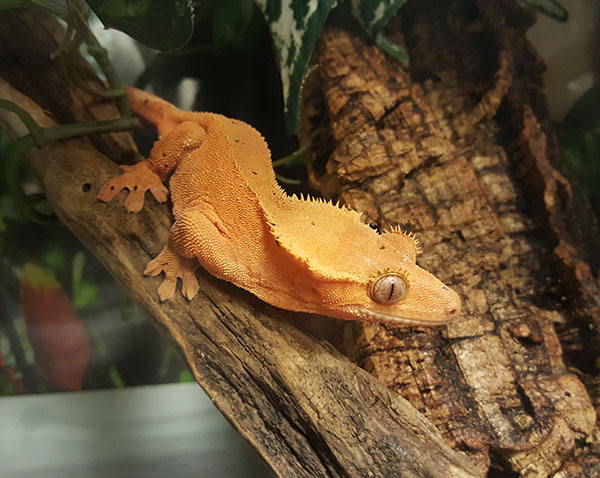New Caledonian Crested Gecko
New Caledonian Crested Gecko
Rhacodactylus ciliatus

Explore More!
General Information
Family: Gekkonidae
Locale: New Caledonia, southern Grande Terre, Isle of Pines and Kotomo (island)
Habitat: Semi-arboreal; found in moist primary forest
Average Size: SVL 4-4.7”; total ~8”
Average Lifespan: >9 years (probably 15+ years)
Activity: Nocturnal
Care Summary
Captive Care: Min. 20 gal high aquarium; enclosures taller than they are long is preferred with a screen lid for maximum circulation. All screen enclosures sold for chameleons also work well. Plants with thin branches for climbing; avoid plants with sharp, protruding twigs. Fake plants also work well. Substrate can be paper towel or newspaper, but a more naturalistic soil/peat mix or unmilled sphagnum moss may be preferred (keep naturalistic substrate moist but not wet, and spot check regularly for fecal material or mold). If using paper towel substrate, have nesting area (open shoe box or Rubbermaid container) with moist sphagnum moss and cork tube standing in it. Need shallow water dish.
Temperature: Thrive in temperatures ranging from 70-85°F, but never more than 85°F (prefer 72-78°F with basking site 78-84° F). Heat may be provided over one end of tank with incandescent light, but monitor temperature so it does not reach too high.
Lighting: No special lighting required. If the terrarium is located near a window, natural light could be sufficient, but never place tank in direct sun. Fluorescent light (UV-B) will benefit the plants and may benefit the gecko.
Diet: Omnivorous, commercially available food preferred; commercially available diets including Pangea Fruit Mix Complete and Repashy Crested Gecko diet. Insects such as crickets, mealworms, flies should also be offered at least occasionally. Require calcium/D3 supplementation in their diet, and should be dusted on insects. If commercial diet is not available, baby food (fruit flavored): apples, peaches, pears, apricots, any flavor aside from citrus fruits may be used. If using primarily baby food, mix 9 parts fruit, 1 part meat (turkey or chicken), and calcium/D3 supplement. Feed small amounts relative to their size either daily or every other day (plastic water bottle lids make good dishes for the baby food mixture). Adjust amount offered based on quantity consumed.
Breeding: Reach maturity between 8 and 11 months (35g minimum), 6-10 clutches of 2 eggs per clutch at 3-4 week intervals. Eggs desiccate quickly if not in moist medium. Winter cool down suggested (3-4 months, ~70°F during day, ~60°F at night). Males have hemipenal bulges, preanal pores, and large cloacal spurs, but lizards need to be 2.7g (maybe) to 3.2g to see. Sex ratios appear to be 50:50 (probably no temperature sex determination).
Temperament: Known to be quite tame, less timid than other Rhacodactylus.
Notes: Do not appear to exhibit TSD. Like to jump. Can be kept in breeding groups of 1 male and 3-4 females. Never house more than one male per enclosure. Tail loss is followed by regeneration of pointy stub. Keeping females separate from males will stop fertile egg production.
References
Bartlett, P.P., Griswold, B. and Bartlett, R.D. (2001). Reptiles, Amphibians, and Invertebrates, an identification and care guide. Barron’s Educational Series, Hauppauge, NY. 279pp.
DeVosjoli, P., Fast, F., Repashy, A. (2003). Rhacodactylus: The complete guide to their selection and care. Advanced Visions, Inc. Vista, CA.pp145-239.
Hamper, R. (2003). The crested gecko in captivity. ECO Publishing, Lansing, MI. 69pp.
Henkel, F.W., Schmidt, W. (1995). Geckos, Biology, Husbandry, and Reproduction. Kreiger Publishing company, Malabar, Florida. 237pp.
Seipp, R., Henkel, F. (2000). Rhacodactylus, Biology, Natural History & Husbandry. Chimaira Buchhandelsgesellschaft mbH. Frankfurt am Main 173 pp.
Pangea reptiles (2010). Received from http://www.pangeareptile.com/id52.htm
Photo: Nadya Mirochnitchenko
Range Map: Shannon Magers
Compiled by Eileen Underwood. Updated 8/2016.
Related Projects
by students in the BGSU Herpetarium
The Herpetarium is a facility in the Department of Biological Sciences.
Bowling Green State University | Bowling Green, OH 43403-0001 | Contact BGSU Herpetarium | Campus Map
Updated: 09/29/2021 03:52PM










